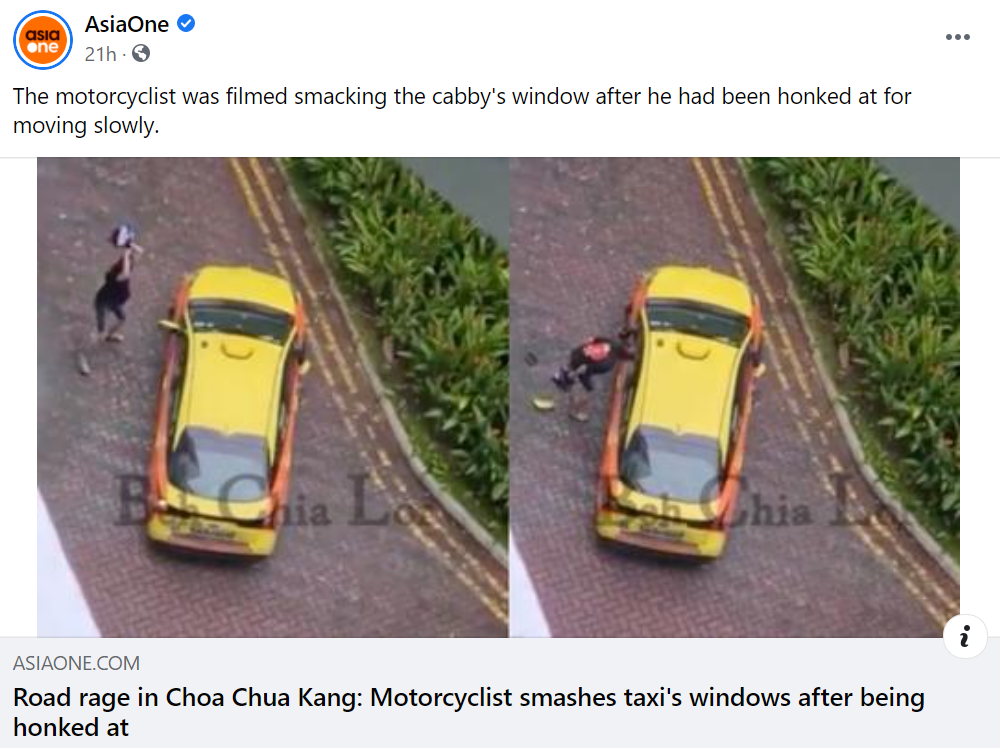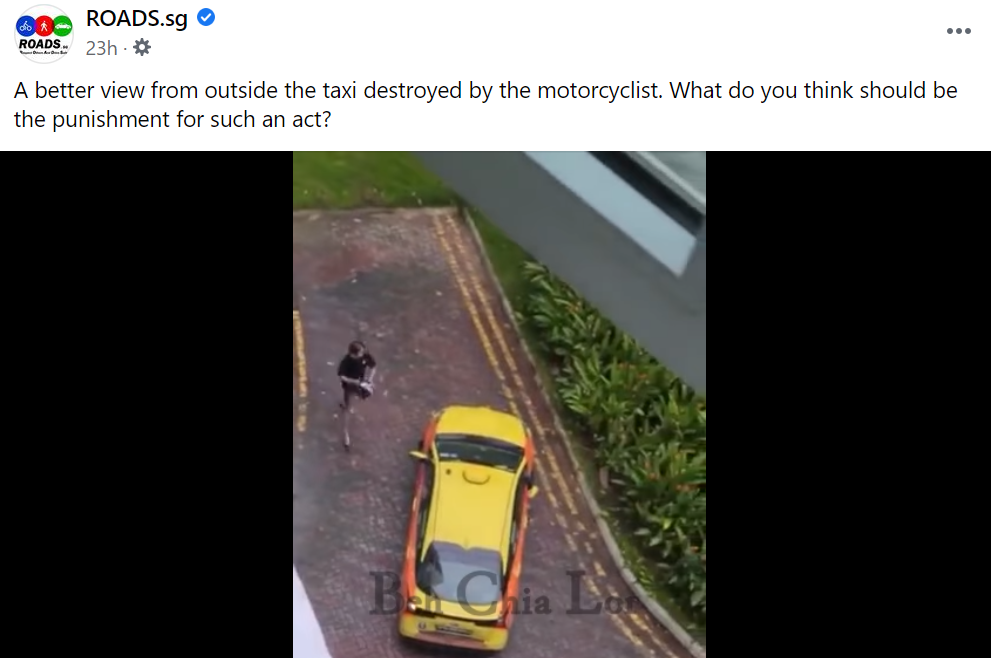Search the Community
Showing results for tags 'singapore taxi'.
-
This story has been trending for the last 48-hours with multiple posts over various FB pages in Singapore. Now, put yourself in the shoes of the taxi driver. If it were me, I would have driven off as soon as the 90s ah beng started shouting. I mean, kudos to the taxi driver for keeping his cool and locking his doors to keep him and his passengers safe. But I think he could have saved his taxi from all that HULK SMASHING if he had driven off. What would you do in the same situation?
- 39 replies
-
- 1
-
.png)
-

Singapore’s very own version of Street Fighter: Bonus stage level
jameskarlchan posted a blog entry in MyAutoBlog
If you’re familiar with the bonus stages in Street Fighter 2, you’ll remember whacking the crap out of a car to get additional points for a high score. We have a Singapore version But unlike Ryu and Ken, this guy uses a motorcycle helmet on a taxi. Here’s the video. The incident happened at Keat Hong Close, Bukit Batok, Singapore. And another angle Why so triggered Based on the video, it’s unclear why the 90s Ah Beng look alike got so heated up. He walks around the taxi yelling profanities and smashing his helmet all over even though there was a child on board. What are the damages? Broken mirror. Make that two mirrors Broken rear window. How much force does one need to use to cause this? And of course, multiple dents and knocks all over the taxi. Police brought in In the video, a male passenger can be heard talking to the authorities on the phone. In the caption of the Facebook post on Roads.sg, it states that the Police arrived to ‘handle the situation’. Online chatter As always, it’s always a joy to read the comments. Thinking of selling your car? sgCarMart Quotz guarantees the highest selling price for your car. We’ll even give you $100 cash if you find a better offer elsewhere! Get a free quote to find out how much your car is worth today!- 7 comments
-
- road rage
- singapore incidents
- (and 8 more)
-
An image uploaded on Beh Chia Lor's Facebook page of a green taxi parking on a patch of green grass happens to be the talk of the office today. Here's the image for your reference courtesy of Beh Chia Lor. What we know Image from https://www.taxisingapore.com/taxi-companies/hdt-electric-taxi/ This green BYD taxi belongs to a taxi company called HDT Taxi. I've not seen or sat in one, but we know that the company's fleet comprises of fully-electric vehicles with a focus on "Going Green". Also, we know that the patch of grass the taxi is on, is not a parking lot. Some scenarios to consider Maybe, the taxi driver thought his car can blend into the grass like a chameleon Maybe, taxi driver thought he John Cena Maybe, taxi driver army siao, like to "Camo On" But, the truth is, we can still see the taxi ah? What the people say Right? Whut? This taxi driver taking the company mission of "going green" too seriously.
-
- 1
-
.png)
-
- byd
- electric car
-
(and 6 more)
Tagged with:
-
Whenever the state of the taxi service is discussed, my mind goes back to 1985. That, in my view, was the last time the Government tried to tackle the problem in a fundamental way. But that experience was so painful, no transport minister since has had the appetite to take on the issue. Which is why the problems persist, almost 30 years on. What is the issue? The Straits Times carried several stories in recent weeks of taxi queues in the city during the evening, with waiting times much longer than they were a year ago. A Sri Lankan businessman was quoted as saying: "It's the worst thing I hate about Singapore - standing in taxi queues." One statistic alone tells the story of how poorly the service here compares with that in other cities: Singapore has 29,000 taxis, Hong Kong has only 18,000. But despite their fewer numbers, Hong Kong taxi drivers make more than a million trips a day, compared with fewer than a million here. So what's happening? That 1985 saga was instructive. I know because I was in the thick of it as a young officer at the then Communications Ministry. The problem then was exactly the same as it is now. Commuters complained they could not get a taxi when they wanted one, that taxi drivers were choosy, refusing to pick up passengers headed for certain destinations, or disappearing just before midnight when the surcharge kicked in. Sounds familiar? At the ministry, it seemed like a straightforward analysis - taxi fares in Singapore were too low, relative to buses and the cost of owning a car. If four people shared a cab, it would be cheaper than taking the bus. The solution? Raise taxi fares substantially to reduce demand, and solve the problem once and for all. But that wasn't all - taxi diesel taxes were also increased to make the cost of owning and running them closer to that of a privately owned car. The theory was sound but, alas, we guessed wrongly how sensitive commuters would be to a big fare hike. Demand for taxis plunged so much that taxi drivers' earnings went down despite the higher fares. There was an uproar: Commuters were unhappy over the increased cost, and taxi drivers were up in arms that their earnings had gone down. The Government had to do an embarrassing U-turn, moderating both the fare and tax increases of the original plan. More significantly though, and with serious implications for the future, it backed off from trying to intervene in the taxi business. So fares were later deregulated and no longer decided by government but left to taxi companies to determine. The number of taxis on the road was also left to the market until recently. But the problems have not gone away, hence the spate of newspaper reports lately. Many suggestions have been made to improve the situation - getting rid of the surcharges, simplifying the fare structure, imposing a minimum cruising mileage, and so on. Indeed, the Land Transport Authority has just announced changes to the rule requiring operators to have a certain proportion of their fleet on the road during peak hours. These moves are worth trying. But I am afraid they will not solve the problem unless Singapore is clear about the role of taxis in its overall transport system. Unless this is settled, the patchwork of measures that have been tried over the years will continue to frustrate. Unlike buses and the MRT, which run on fixed routes, taxi demand is more unpredictable, driven by those whose needs cannot be met by public and private transport. This includes regular bus and MRT commuters who occasionally use taxis, tourists, and even motorists who sometimes find it more convenient not to drive. How to devise a system to meet so many of these different needs with no obvious pattern to them? It turns out that getting the price right is the most important. If it is set too low, demand will surge and service levels will deteriorate unless the roads are flooded with taxis, which isn't possible without causing serious traffic congestion. If it is set too high and demand collapses, neither commuters nor drivers will be happy, as was the case in 1985. Because it is so important to get the price right, it cannot be left to taxi companies to decide. They have other commercial considerations when setting the price and may not necessarily take into account the proper role of taxis in the overall transport system. Indeed, as many critics have pointed out, because their revenues come from renting the taxis out, they have no direct interest in providing good service, apart from meeting minimum regulatory standards. For these reasons, the correct fare level ought to be decided by the transport authorities, taking into account the overall transport system. In Singapore, this price should be pegged between public and private transport. One other factor needs to be taken into account, which is often overlooked. This is the effect price has on taxi driver behaviour. If the price is set too low, cabbies have to pick many fares through the day to make a decent living. Each fare then becomes relatively unimportant because it represents a smaller part of his overall earnings, as he knows he can pick another fare just round the corner. Taxi drivers operating in this scenario tend to be choosy about the fares they pick. On the other hand, if the price is set higher and demand is lower, you can expect better service as every customer contributes a larger share to the driver's earnings. It's the difference between a supermarket and a boutique. Both types of taxi service can be found all over the world - the supermarket model prevailing in developing countries, whereas in, say, Tokyo or London, it's a boutique service. What's critical is that whichever model is chosen must not result only in better service for commuters but also give taxi drivers a better deal going forward. Their livelihood has to be a priority because a good taxi service can happen only when cab drivers believe there is a secure future for them, they earn decent wages, and have a profession that others respect. So, whenever changes are made to the taxi service, one critical question to ask is: Will taxi drivers be better off as a result? There is much work that needs to be done to make these fundamental changes that will result in permanent improvements to the taxi service: determining which taxi model is best for Singapore, setting the correct fare level, the number of taxis needed, the cost of owning and operating them, and the way the business is operated. These issues require decisions that only the Government can make. But it has to first exorcise the ghost of 1985. -- ST PHOTO: Neo Xiao Bin by Han Fook Kwang
- 4 comments
-
- taxi woes
- taxi problems
- (and 6 more)
-
Let's talk about a taxi that's been a favourite for so many years over in Singapore, Japan and some people say Hong Kong - The Nissan Cedric. In the mid 1980s, the Y31 Cedric, a very English sounding name for a car, as well as the Toyota Crown were the favorite for all taxi operators in the region. These taxis looked like luxury specced Cedrics/Glorias but were actually stripped-down versions, with an emphasis on operating costs over total comfort. These diesel Nissan Cedrics were popular among Singapore taxi operators,but they were unable to meet the new emissions standards in 2006, and were no longer be offered for sale as a taxi. But the great thing is that the car is STILL being sold over in Japan to this very day. These Y31 Cedrics were first produced in 1987 and somehow Nissan recognized the potential in making the car as a taxi and these evolved into the YPY31 in 1991 to something of a full taxi spec vehicle with the advent of the Y32 Cedric replacement. The taxi spec YPY31 Cedrics had cheaper plastic fittings instead of wood trim and PVC seats instead of leather. The sound proofing was removed to save weight and cost, and early generation (i.e, smokey) diesel engines replaced the original large capacity petrol units. The resulting vehicles were simple to maintain and extremely reliable, but were lacking in comfort, with very high levels of NVH. Anyone who rode in one would know what I meant. Since the end of 2006/early 2007, these older diesel YPY31 Cedrics were unable to meet the new Euro4 standards that came into effect, governing the sale of cars on the Lion City resulting in taxi operators trying out everything that they could get their hands on. We've seen Hyundai Sonata, Chrysler 300c, Fiats, Toyota Camrys, various MPVs and shoeboxes that now bear the 'taxi' sign. Let me now present the 2011 Model Year Nissan Cedric. Which in Japan meets all 2005 (Euro4) emissions standards when everyone has moved on to Euro5 emissions recently. The best, or worse thing about this Cedric is that it still looks like its so stuck in 1987 from the outside and also from the inside. It's 2010 for Godsake and isn't Japan a world leader when it comes to automotive technology? If we were in India, a country were they still produce the Moris Oxford based Hindustan Ambassador then it would be different. Of course, a car from the 1980s isn't as bad as something from the 1960s. Take a look at that chunky and square body.Actually, don't, as you could still see some of them everyday in downtown Singapore. Everything is still upright and square without an ounce of aerodynamic detail. This helps with the interior and boot space of course. Passengers and lots of luggage can be carried comfortably. The interior sports very traditional slider style air condition/ventilation controls. If you notice, cars nowadays use rotary knobs and fully automated buttons for the air-condition controls. These are really stuck in the 1980s. Of course, they are simple and robust, but boy, are they outdated. It has some 'wood' trim for some semblance of luxury though. These cars are marketed by Nissan in Japan as commercial or for fleet (read, hire car/taxi) operators. And how it reaches Euro4 standards is that its 2.0liter engine is LPG powered and comes with Idling Stop & Start function, which is something very 2010 instead of 1987. The car makes 10km/ltr in the urban/extra urban mode and has a C02 emissions of around 168g/km. It achieves all of this even with an ancient 4 speed automatic transmission that must have been around since 1987 and has rear wheel drive. What is even shocking is that the engine only makes a measly 84bhp and 170Nm of torque. And this tiny amount has to lug 1470kg around (without a driver and passengers). This lack of power to certainly due to the use of LPG as LPG is around 15% less potent than using petrol. This slight lack of power also effects fuel consumption. But since LPG is cheaper and cleaner, this somewhat offsets the power loss and fuel consumption too. So what do you think? Would taxi operators around here be willing to take on another round of Nissan Cedric taxis in LPG form if Nissan brings this 2011 Cedric in from Japan? Or since they've gotten used to better ride, refinement and handling from newer and better equipped cars from Europe, Japan or Korea would they now shun it like the plague? Well, the operators in Japan sure don't.
- 6 comments
-
- singapore taxi
- nissan
-
(and 2 more)
Tagged with:



